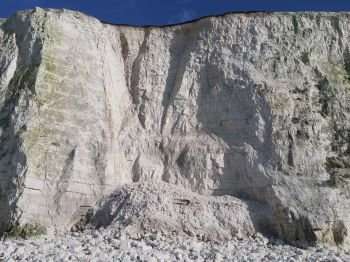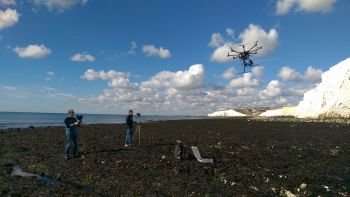Why Britain's coastline is crumbling

Britain is changing shape. More than 50 per cent of the coastline is made of cliffs and while In some places erosion is just a centimetre or two each year, in others an average of 89 centimetres of the chalk face is falling into the sea every year.
In June 2017 a ten-metre section of the cliff at Seaford Head in East Sussex disappeared. No one was hurt, but it drew attention again to the dangers of standing too close to the edge.
"You don't need an obvious fissure in the ground to be a sign that the cliff might collapse," says Dr John Barlow, a geomorphologist at the University of Sussex. "The formation of the rock varies along the coast. You might not see any evidence, but even if you're six metres from the edge the ground below could be structurally weak."
It is these weaknesses that Dr Barlow is now studying. With the aid of a drone aircraft that's photographically mapping a section at Telscombe in East Sussex, he and his team have been able to make highly accurate 3D models of the cliff face.
They are spotting the cuts and notches at the base caused by waves, and identifying the "over steepening" that can lead to those fragile ledges just falling away.
"People haven't been killed, but that doesn't mean it can't happen," says Dr Barlow. "The most dangerous times are at high tide or in bad weather, which doesn't necessarily preclude people being in those places."
Besides gathering evidence of recent rock falls, Dr Barlow and his team they will also be able to predict future events based on calculations that connect the height and energy of the waves with what's happening at the cliff base.

Telscombe, which doesn't have the protection of a seawall, is particularly at risk. The A259 coast road is just 42 metres from the edge at its closest point. As erosion continues, his predictions are that by 2089 the road has a one in ten chance of being lost to the sea. "I think that's a pretty serious threat."
Even in places where a seawall exists, the cliffs are gradually retreating through storm damage, rainfall and freeze-thaw conditions.
Compared with some other maritime cliffs in the UK, the cretaceous chalk cliffs of Sussex – formed from the exo-skeletons of tiny marine animals that fell to the bottom of the sea more than 70 million years ago - are quite soft and vulnerable.
The fall at Seaford Head was a typical example of what geomorphologists identify as "toppling failure", caused by vertical cracks in the cliff face that leads to sections of rock to toppling like dominoes as the base of the cliff is eroded by waves
Another other type of large fall, a "wedge failure", occurs when two cracks intersect at an angle, causing a wedge of rock to slide away like a piece of cake
In fact, a chalk slope only reaches stability when its incline drops to around 30 degrees, which is the case for much of the ancient South Downs.
Dr Barlow says: "Our data suggest that increased storminess and rising sea levels will lead to a six per cent loss by 2089. It might sound alarming, but it doesn't look like we'll be losing our magnificent cliffs just yet."
Provided by University of Sussex



















